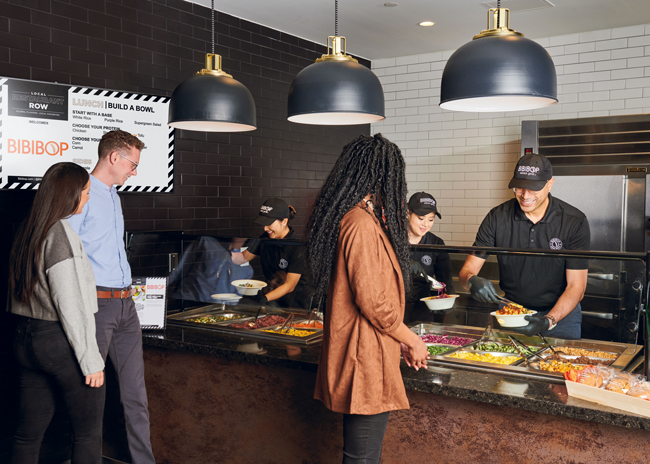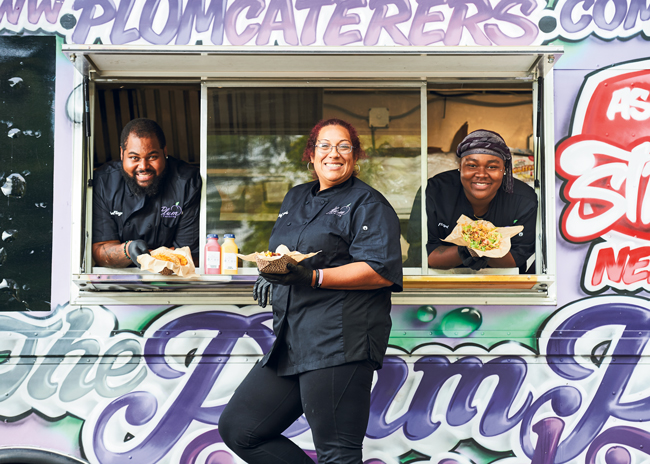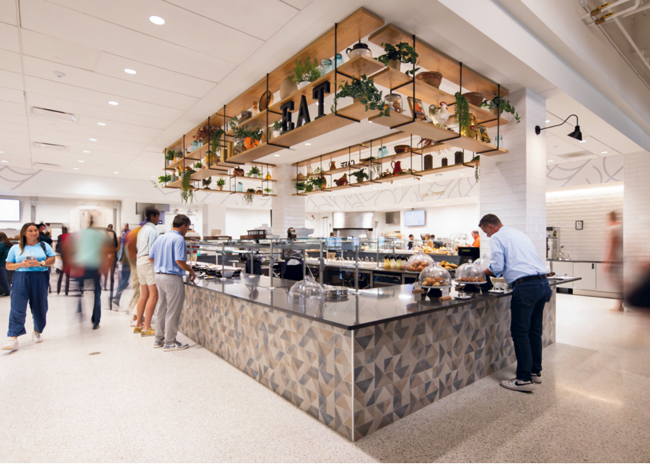Foodservice operators consist of two general sides. One is the world of restaurants, whose prime directive is to please paying customers and make a profit. The other is noncommercial foodservice operators.
In these instances, foodservice means feeding people who are gathered at that location for a purpose beyond dining. Examples of noncommercial operators include K-12 schools, colleges and universities, healthcare settings, corporate buildings, factories and more.
What can restaurant operators and chefs learn from the noncommercial side of foodservice? Let’s take a look.
Key Differences
 “Compared to restaurants, noncommercial foodservice operations have more diversification in what they offer,” says Tim O’Mara, senior project manager at Cini-Little. “They have a more-or-less captive audience, and menu fatigue can become a big issue. Noncommercial operators have to constantly think about new menu items and new concepts. They’re looking for pop-ups, local restaurants brought on as part of the menu rotation, something different.”
“Compared to restaurants, noncommercial foodservice operations have more diversification in what they offer,” says Tim O’Mara, senior project manager at Cini-Little. “They have a more-or-less captive audience, and menu fatigue can become a big issue. Noncommercial operators have to constantly think about new menu items and new concepts. They’re looking for pop-ups, local restaurants brought on as part of the menu rotation, something different.”
In contrast, O’Mara says, “Many commercial operators, big chains especially, have been designed for one type of service. Restaurateurs could learn from noncommercial operators about menu change, adaptability and ways to maximize revenue outside the walls of their brick-and-mortar building.”
Also central to noncommercial foodservice is a process orientation, O’Mara says: “On-site operators develop a menu item through menu engineering and analysis, costing it out ingredient by ingredient and standardizing the recipe through the organization. Chain restaurants do that, but smaller operators often don’t. More restaurants need to adopt that process mindset so they can determine what the expected return on investment is before putting a new menu item out there.”
Noncommercial operators take a longer-term view when purchasing their equipment, which means they focus more on ROI and longevity than purchase price because they keep the equipment longer. Lisa Paige-Pretorius, a senior project manager with Cini-Little, notes that commercial restaurants could embrace this approach more frequently: “Restaurants that do ROI calculations will dial into the quality of the pieces they purchase, spending extra for versatile pieces that may perform higher-volume production in smaller footprints and adding on maintenance packages to ensure continuous operation and reduced equipment failure.”
Karen Malody, founder of consulting firm Culinary Options, has worked with both commercial and noncommercial operators. She says each has something to learn from the other. She says noncommercial operators “are expanding their viewpoint about foodservice. They’re becoming more creative, developing food concepts beyond the deli, grill or soup station.”
And these operators understand kitchen efficiency and versatility. “They’re using different methods — a la minute cooking, cook-chill, value-added products — and making efficient use of expensive equipment like new combis, blast chillers and blast freezers. And they’ve learned how to most efficiently organize labor.” Malody notes that noncommercial kitchens may be designed before the concept is finalized and must also survive periodic turnovers of contractors or operators. They’re future-proofed with “equipment on casters and lots of connectivity.” In contrast, a pizza restaurant knows it’s a pizza restaurant from the start. All of this impacts design, equipment and more.
Commercial kitchens may benefit from understanding how typical noncommercial operators take full advantage of ways to prep and cook food in advance of service, Malody says. “Keeping up with food orders in the kitchen is where menu engineering comes in,” she notes. “Knowing what to precook means service doesn’t take too long, and food that has been made ahead will look beautiful if it’s finished and presented properly. You can use a combi to par-steam boneless chicken breasts, blast chill them and put them on the line to finish on the grill. And if there’s also a clamshell grill where the top platen comes down to brown both sides of the chicken in less than a minute, you get beautiful browning.”
Beyond batch precooking, some combi ovens feature overnight slow-cook and cook-and-hold features that can give commercial and noncommercial operators “a third shift without bodies,” Malody notes.
Yet too many operators that have advanced combis and grills don’t use them optimally to maximize production and flavor, Malody says. She urges all chefs and operators to turn to equipment dealers and manufacturers for assistance on how to take full advantage of the equipment’s advanced features.
Hospital foodservice does not always have the best reputation among consumers, yet the quality and creativity of the food in this segment continue to rapidly evolve. Chef Michael Salvatore, CEC, senior director at Ruck-Shockey Associates, believes restaurant operators can learn from healthcare foodservice operators. “The first glaring difference between the healthcare world and commercial foodservice is in the attention to sanitation,” he says. Commercial restaurants do follow proper cleaning and sanitation procedures, but in a healthcare operation that goes to the next level because a portion of the population in these areas often has compromised immune systems, Salvatore explains: “I’m not saying restaurants are messy — but they’re not clinical, either.”
Salvatore suggests that restaurant operators train all staff members in ServSafe or a similar HACCP-based food-safety program, not just the minimal level of one trained person for each shift. In a restaurant group, he envisions “a management-level person reporting to the general manager. Food safety would be all they do — checking dates in logs, making sure test strips are done, training staff.” Major chains, multiconcept operators and large hotels already have such a person or department, Salvatore notes, but he suggests that mid-size organizations should reevaluate the chain of responsibility for sanitation compliance to ensure their operations meet the highest possible level of safety and consistency, if not the same standard as a hospital foodservice environment.
Salvatore has, in fact, been musing on the idea of creating a certification program for the kind of job he describes. “We could call it the SaniTsar,” he says.
 Through Aramark’s Local Restaurant Row program, Elkton, Md.-based Plum Caterers has both restaurant stalls and Plum Pit food trucks at a number of Aramark accounts, purveying an eclectic lineup of sandwiches, tacos, rice bowls and empanadas. Photo courtesy of Aramark
Through Aramark’s Local Restaurant Row program, Elkton, Md.-based Plum Caterers has both restaurant stalls and Plum Pit food trucks at a number of Aramark accounts, purveying an eclectic lineup of sandwiches, tacos, rice bowls and empanadas. Photo courtesy of Aramark
Menu Consistency and Equipment Choices
Healthcare foodservice operators also excel at menu consistency, says Salvatore. Understanding the full array of how healthcare foodservice navigates menu consistency could help commercial operators, he notes. Especially for smaller operators, supply-chain headaches are behind many inconsistencies, he points out: “If you get a frozen product this week, fresh next week and frozen the week after, you’re going to have inconsistent results. And it creates all kinds of problems when brands or pack sizes change.”
The solution? Don’t let your supplier guess what you want to do when product availability changes, Salvatore advises. “Don’t have an ‘us against them’ mentality; work with your supplier so that you’re really partners in business,” he says.
For all operators, making the best use of the latest equipment and technology is another key to consistent results, Salvatore says. “Combi ovens, immersion circulators and air fry ovens can all be programmed, but it takes work,” he says. “You’ll deliver better, more consistent results if you’re testing 50 or 100 portions of something so you can dial to the exact second to get the results you want.”
Salvatore outlines this fundamental approach to kitchen design and specifying the right equipment to support the kitchen team: “The concept comes first, then the menu, then the recipes, item by item and process by process. How do I receive the food, what environment does it go to for storage, where does it go when it comes out of storage, what is done to prepare it? Map that process all the way through sanitation and disposal.”
 The new headquarters building for Bandwidth, a technology services company in Raleigh, N.C., has 1,000 employees and no nearby restaurants, making on-site foodservice quality and variety critical. The Wild Turkey Café is modeled on a global food hall, offering everything from ramen bowls to artisan pizzas to grab-and-go snacks; The Bandstand coffee bar, a partnership with local coffee shop 321 Coffee, offers pastries from the local La Farm Bakery.
The new headquarters building for Bandwidth, a technology services company in Raleigh, N.C., has 1,000 employees and no nearby restaurants, making on-site foodservice quality and variety critical. The Wild Turkey Café is modeled on a global food hall, offering everything from ramen bowls to artisan pizzas to grab-and-go snacks; The Bandstand coffee bar, a partnership with local coffee shop 321 Coffee, offers pastries from the local La Farm Bakery.
Equipment as Key to Labor Efficiency
For contract foodservice provider Aramark, the priorities “always come down to labor efficiency and automated machines that can cook faster and cheaper while keeping the same quality,” says James Thorpe, Aramark’s senior foodservice designer, concept design and innovation. “Restaurants can learn from us how to use newer equipment and processes — back and front of house — to handle labor.”
Thorpe seeks “automated equipment and processes that can cook food faster and keep the same quality.” A top example is an egg cooker that “holds 30 eggs and can cook them soft, medium or hard,” he says. “How long does it take to crack 30 eggs and cook them? This machine does it in seconds. We’re looking to implement fresh egg sandwiches; now they can be done quickly, and we don’t have to worry about breaking eggs.”
Modern equipment can save labor in many ways, Thorpe says. “Now, a single worker can be running three pieces of equipment at once, all by just hitting a button, and all timed,” he says. “You can hire workers with a different skill set and still give customers great-tasting food. Some cooking equipment even has built-in training; you can hit a button and watch a video on how to cook the item.”
Maintenance and cleaning are other areas where modern equipment saves labor, Thorpe points out: “A self-cleaning feature not only keeps the quality of the equipment up to spec but also takes away the labor of having to spray down the unit daily.”
Thorpe also praises ventless technology, which makes it easier to use smaller, specialized cooking equipment for small-scale cooking to order. Thorpe points out where it’s especially useful: “There’s been a trend among our smaller clients of getting away from full cafes and instead having a micromarket or a barista station with a pickup window and flexible seating. Customers want convenience, but they don’t want bland food.”
Thorpe, a longtime judge for the Kitchen Innovation Awards showcased annually at the National Restaurant Association Show, says that restaurateurs can learn about new equipment easily even if they can’t visit the NRA Show or trade shows out of town. “A lot of local reps have new equipment on display in a showroom, and it’s easy to find a showroom, call up and go visit,” he says, adding that local reps typically offer training on equipment.
 Noncommercial foodservice kitchens, like this one at the newly redesigned Citi Tampa headquarters, may be much larger than restaurant kitchens. And because foodservice is usually subsidized, they can incorporate specialized equipment for batch cooking. Photos courtesy of Cini-Little
Noncommercial foodservice kitchens, like this one at the newly redesigned Citi Tampa headquarters, may be much larger than restaurant kitchens. And because foodservice is usually subsidized, they can incorporate specialized equipment for batch cooking. Photos courtesy of Cini-Little
Outside Wins
Catering and the use of central production kitchens are two areas that provide wins for noncommercial operators that restaurants could consider if they’re not already part of the business, consultants agree. “Catering affords you the luxury of doing more business without adding more square feet or seats,” explains Salvatore. “It has different peak times than restaurant dayparts, and it’s more profitable because it allows for production control.”
Paige-Pretorius adds that restaurateurs who want to expand to delivery and catering will need to think differently about cooking methods. “A lot of restaurants fill all orders a la carte. To do catering, they will have to do batch cooking — for instance, using a combi to prepare multiple entrees at a time instead of one,” she explains.
While catering is a possibility for many restaurants, Salvatore says, “The perfect incubators are restaurants that have grown to several units and have a central production kitchen that allows for consistency.” Central or commissary kitchens have many advantages, he says. “At about four units, you can start to realize economics of scale,” he explains. “You can centralize production of soups and sauces that require a lot of overwatching if you’re trying to do them consistently in unit kitchens. Soup is a perfect first step, even if you have to use a shared kitchen.”
Centralized batch production also requires specialized equipment. “You’ve got to have some type of cook-chill system, probably some type of reduced-oxygen packaging, and because reduced-oxygen environments are favorable for pathogens, a robust HACCP plan and probably equipment that automatically logs time and temperature,” Salvatore explains. “But you still need to cool your soup properly. A blast chiller would be lovely — not cheap, but highly effective.”
Commercial/Noncommercial Collab
Noncommercial foodservice operators are incorporating restaurant brands into their offerings —not only including national chains but also integrating local operators.
“I do pop-ups with a lot of local restaurants,” says Leisa Bryant, director, food and nutrition service, at The University of Texas MD Anderson Cancer Center. When local restaurants come on campus, MD Anderson provides them with some kitchen space. “When we collaborate with restaurants to leverage each other for success, we look at scalability. Kitchen spaces and equipment are at a premium, and rents are high. We have space available in large kitchens, including a beautiful kitchen we haven’t been using since COVID-19 where we have a contract with a local restaurant owner. She doesn’t pay us rent; she has access to state-of-the-art equipment and has been trained to meet our regulatory and sanitation requirements. Her team provides sushi and Asian foods for our cafe, and we get a percentage of the sales revenue.”
Many institutional foodservice operations have kitchens that aren’t being used, Bryant says. “Restaurants may want to rent a kitchen or partner with the host institution. If you’re running an evening business, and I’m running a morning business, can your staff work with me for four hours a day?”
Aramark operates a formal partnership program called Local Restaurant Row that helps noncommercial operators form partnerships with local restaurants, says Diane Pancoski, Aramark’s vice president of marketing strategy and innovation. “Site managers and chefs may bring a local restaurant to our attention, and we also have a team that vets local restaurants. We work with them, put them into our system and any manager in any location can schedule a restaurant to take over a station as a pop-up. For a big company-wide event, people love to have local restaurants represented — whether it’s sushi or Indian meals, barbecue or cupcakes.”
Food trucks are another big part of Aramark’s program with “a huge network throughout the country,” Thorpe says.



